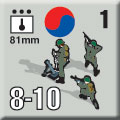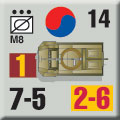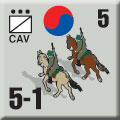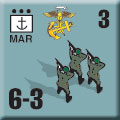| Pusan Perimeter:
The South Koreans
By Mike Bennighof, Ph.D.
October 2022
 In the first scenarios of Korean War: Pusan Perimeter, the badly-outgunned Republic of Korea Army (ROK) attempts to hold off the North Korean invasion of June 1950. Unable to stop the onslaught, they are steadily pushed back into the perimeter around the port of Pusan in the peninsula’s southeastern corner, even as United Nations-sanctioned American reinforcements arrive to help them. In the first scenarios of Korean War: Pusan Perimeter, the badly-outgunned Republic of Korea Army (ROK) attempts to hold off the North Korean invasion of June 1950. Unable to stop the onslaught, they are steadily pushed back into the perimeter around the port of Pusan in the peninsula’s southeastern corner, even as United Nations-sanctioned American reinforcements arrive to help them.
Despite their lack of equipment, weapons and training, the ROKs fought surprisingly hard against the invaders. While it took American (and Allied) firepower to hold the perimeter and eventually recover today’s South Korea, there would have been no perimeter to hold without the bloody, valiant stands of the ROK Army and Marines
.
The ROKs lacked the tough, long-service cadres of the North Korean People’s Army (who had been honed by years or even decades of fighting in Mao Zedong’s Chinese Communist ranks or in the Red Army of Workers and Peasants). Even so, ROK units saw a good bit of action during the years just before the war, suppressing Communist-inspired uprisings across South Korea and particularly on the large island of Cheju-do off the peninsula’s southwest coast. Tens of thousands were massacred, often indiscriminately.
Here’s a look at the pieces that make up the ROK Army forces in Pusan Perimeter:
Infantry
  
The ROK had a small nucleus of experienced soldiers and officers, many of whom had served in the Japanese armed forces and some in those of the puppet empire of Manchukuo. Their weaponry mostly came from the large stocks of Arisaka rifles and Nambu light machine guns left over from the Japanese garrison, plus some American-provided small arms. In 1950, thanks to American assistance during the pre-war operations against Communist guerillas, the South Korean police were often better-armed than the ROK Army’s infantry.
A number of clashes took place along the 38th Parallel during the spring of 1950, as the North Koreans probed Southern defenses and tested the enemy’s readiness. All of these were carried out by infantry alone, and no tanks were ever seen along the border. Therefore, the appearance of North Korean T-34/85 tanks during the NKPA invasion came as a great shock to the ROK troops, who had little training to deal with them and inadequate weapons to counter them.
 
The ROK has separate bazooka team units, wielding the inadequate 2.36-inch rocket. I'm not sure I would have designed the game that way (instead of integrating them with the infantry units), but I wasn't the designer. They also have anti-tank teams armed with demolition charges and an excess of bravery.
“Heavy” Weapons
 
Some South Korean artillery batteries had the American-made 75mm pack howitzer, a very effective weapon for its intended role (supporting airborne or mountain troops, and transportable by pack mule). As a substitute for real artillery, it was sadly inadequate.
The Americans armed most ROK artillery batteries with the M3 105mm short-barreled howitzer, a weapon derived from the deadly M2 that equipped American artillery regiments. The M3 was a lightweight weapon with the same carriage as the 75mm pack howitzer, and intended for use by airborne artillery battalions and infantry regiment cannon companies. By issuing this weapon to the ROK instead of its fully-grown sister, the Americans hoped to reduce the chances of a rogue attack against North Korea. The “Short” had been intended to fire the same round as the big gun, but ended up with a reduced charge that gave it a shorter range and less punch.
  
With no North Korean armor expected to be seen in any conflict with the South, the Americans provided their cast-off anti-tank guns: the totally-outclassed 37mm anti-tank gun and the obsolete 57mm gun. The 37mm weapon had already been rendered useless before American troops saw combat in World War II; the 57mm gun had still been potent when introduced but was not adequate against the newest German tanks by the end of the war. The more capable 3-inch anti-tank gun had been discarded after heavy losses during the Battle of the Bulge due to its great weight, and it was not issued to the South Koreans.
The Americans did supply some of their M1 81mm mortars and the ROK had a number of Japanese-made Type 97 81mm mortars left over from the Imperial Army’s stockpiles. Both weapons were closely derived from the French Brandt 81mm Mle27 mortar, and could fire the same ammunition.
“Armor”
  
No tanks had been provided to the ROK Army in 1950. As with artillery, there seems to have been a concern – probably well justified - among the American military mission that offensive weapons would be used offensively, probably at the first opportunity. A handful of leftover Japanese Type 95 light tanks had been put into service but actual armor would have to wait until some M4 Sherman “Easy Eight” models were handed over much later in the Korean War.
What few mechanized vehicles the South Koreans did possess were concentrated in the Capital Division’s 1st Cavalry Regiment. While the Capital Division would fight very well during the Korean War and later in Vietnam, in June 1950 it was considered a parade-ground unit not suitable for front-line combat and held out of the fighting during the first few days. When they finally (and enthusiastically) entered the fighting the 1st Cavalry Regiment had two dozen armored cars and a dozen halftracks. Plus some actual horsed cavalry.
Marines
  
South Korea formed its Marine Corps in 1949, initially just a small battalion armed with formerly Japanese weapons. It saw action against Communist insurgents before the North Korean invasion, and fought well during the initial NKPA attacks. It would expand steadily through the Korean War, forging a close connection to their American counterparts, and elements landed at Inchon alongside U.S. Marines.
The ROK Marines have better firepower than the equivalent Army units, and their leadership is pretty good, too. In scenarios they have strong morale as well. There aren’t very many of them, but they will make their presence felt.
Click here to order Pusan Perimeter.
Sign up for our newsletter right here. Your info will never be sold or transferred; we'll just use it to update you on new games and new offers.
Mike Bennighof is president of Avalanche Press and holds a doctorate in history from Emory University. A Fulbright Scholar and NASA Journalist in Space finalist, he has published a great many books, games and articles on historical subjects; people are saying that some of them are actually good.
He lives in Birmingham, Alabama with his wife, three children, and new puppy. He misses his lizard-hunting Iron Dog, Leopold.
Want to keep Daily Content free of third-party ads? You can send us some love (and cash) through this link right here.
|
